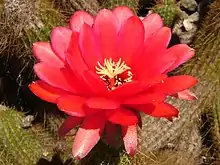Soehrensia huascha
Soehrensia huascha, is a species of Soehrensia in the Cactaceae family, found in north western Argentina.[2] First published in Cactaceae Syst. Init. 29: 5 in 2013.[2]
| Soehrensia huascha | |
|---|---|
 | |
| Scientific classification | |
| Kingdom: | Plantae |
| Clade: | Tracheophytes |
| Clade: | Angiosperms |
| Clade: | Eudicots |
| Order: | Caryophyllales |
| Family: | Cactaceae |
| Subfamily: | Cactoideae |
| Genus: | Soehrensia |
| Species: | S. huascha |
| Binomial name | |
| Soehrensia huascha (F.A.C. Weber) Schlumpb. | |
| Synonyms | |
|
List
| |
Was formerly thought to be a species of Echinopsis.[3]
Description
The plants usually branch at the base and form low groups with heights of up to 1 meter. The cylindrical, fresh green, upright or creeping trunks with an erect shoot tip have 14 to 17 ribs and reach about 5 centimeters in diameter. The areoles, from which the yellowish to brownish, needle-like thorns arise, reach a diameter of up to 1 centimetre. The 1 to 3 central spines are slightly thicker than the radial spines and are between 2 and 7 centimeters long. The 9 to 11 radial spines are up to 1.5 inches long.
The funnel-shaped to bell-shaped flowers that appear near the apex are very variable. They open during the day and are up to 10 centimeters long and up to 7 centimeters in diameter. The olive green, 4.5 centimetre long flower cup is covered with 4 to 6 millimetre long, brownish to black hair.
The spherical to egg-shaped fruits are yellowish green or reddish and reach a diameter of up to 3 centimeters.[4]
 Plant
Plant.jpg.webp) Yellow Flower
Yellow Flower Orange flower
Orange flower Plant closeup
Plant closeup
Subspecies
It has 2 accepted subspecies;
- Soehrensia huascha subsp. huascha
- Soehrensia huascha subsp. robusta (Rausch) Schlumpb.
Distribution
Soehrensia huascha is widespread in the northwest of Argentina in the provinces of Catamarca and La Rioja and grows at altitudes of 500 to 2000 meters.
Taxonomy
The first description as Cereus huascha was published in 1893 by Frédéric Albert Constantin Weber.[5] The specific epithet huascha is derived from a local Argentine word meaning orphan. Boris O. Schlumpberger placed the species in the genus Soehrensia in 2013.[6] Further nomenclature synonyms are Trichocereus huascha (F.A.C.Weber) Britton & Rose (1920), Lobivia huascha (F.A.C.Weber) W.T.Marshall (1938), Helianthocereus huascha (F.A.C.Weber) Backeb. (1951), Salpingolobivia huascha (F.A.C.Weber) Y.Itô (1957) and 'Echinopsis huascha (F.A.C.Weber) H.Friedrich & G.D.Rowley (1974). There are numerous other synonyms.
References
- "The IUCN Red List of Threatened Species". IUCN Red List of Threatened Species. 2010-09-22. Retrieved 2023-08-27.
- "Soehrensia huascha (F.A.C.Weber) Schlumpb. | Plants of the World Online | Kew Science". Plants of the World Online. Retrieved 29 October 2022.
- "Echinopsis huascha". Tropicos. Retrieved 2019-08-22.
- Anderson, Edward F.; Eggli, Urs; Anderson, Edward F. (2005). Das große Kakteen-Lexikon (in German). Stuttgart (Hohenheim): Ulmer. p. 231–232. ISBN 3-8001-4573-1.
- "Monatsschrift für Kakteenkunde". J. Neumann. 1893. Retrieved 2023-10-01.
- Korotkova, Nadja; Aquino, David; Arias, Salvador; Eggli, Urs; Franck, Alan; Gómez-Hinostrosa, Carlos; Guerrero, Pablo C.; Hernández, Héctor M.; Kohlbecker, Andreas; Köhler, Matias; Luther, Katja; Majure, Lucas C.; Müller, Andreas; Metzing, Detlev; Nyffeler, Reto; Sánchez, Daniel; Schlumpberger, Boris; Berendsohn, Walter G. (2021-08-31). "Cactaceae at Caryophyllales.org – a dynamic online species-level taxonomic backbone for the family". Willdenowia. Botanic Garden and Botanical Museum Berlin, Freie Universitaet Berlin. 51 (2). doi:10.3372/wi.51.51208. ISSN 0511-9618.
External links
 Media related to Soehrensia huascha at Wikimedia Commons
Media related to Soehrensia huascha at Wikimedia Commons Data related to Soehrensia huascha at Wikispecies
Data related to Soehrensia huascha at Wikispecies
